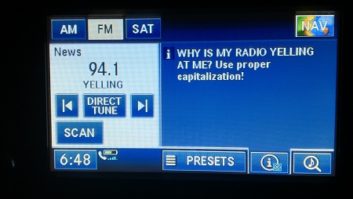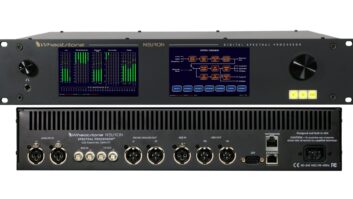Consumers have become accustomed to seeing title and artist information displayed when listening to music on all types of devices. In addition, as radio receiver designs evolve, more of them are displaying program-associated data via RDS/RBDS and HD Radio technologies.
However, what’s lacking is “a cohesive consumer experience across devices and even stations,” according to Steve Davis, chairman of the RDS Usage Working Group of the National Radio Systems Committee and senior vice president of engineering and capital management for Clear Channel Radio.
“Some use one field for a station slogan, while others might use that for title and artist. This leads to frustration and even sometimes people incorrectly thinking their radio ‘isn’t working.’”
Members of the working group wanted to answer the question, “How can we best encourage receiver manufacturers to include displays with larger amounts of text?”
It sounds like a simple query, but in order to make recommendations to the industry, the RUWG decided to do an in-depth analysis and make suggestions based on hard facts.

The group surveyed broadcasters on how RBDS is being used, and asked manufacturers how RBDS is implemented. It then crafted guidelines that members hope will help guide radio stations display the data in the most consistent fashion for a repeatable user experience, according to Davis.
The guidelines, contained in “NRSC-R300 Program-Associated Data Field Length Study,” will also help manufacturers by ensuring them that the experience will be similar on a given device across multiple stations, he said.
RBDS Subcommittee Chair Barry Thomas echoed the notion of consistent display. Through the working group, the subcommittee has been working on a companion piece to the recently-adopted NRSC-4-B standard, a guideline for broadcasters and receiver manufacturers’ use of RBDS, a “best practices” document that can be used by engineers and programmers, according to Thomas, who’s also vice president of engineering for Lincoln Financial Media.
“It became clear that we needed data to inform discussions about title and artist display sizes, and message repetition guidelines,” Thomas said. “The working group initiated what we believe to be the most comprehensive analysis of its kind. With this research, we can offer recommendations for field lengths, interleaving and repetition based on statistical analysis, not inference.”
[Sign Up for Radio World’s SmartBrief Newsletter]
Song data
In order to best educate the industry, the most logical solution would be to cultivate statistics from a large group of song material that might be displayed on RDS/RBDS and HD Radio receivers.
Clear Channel provided its database of approximately 149,000 individual songs with title, artist and, when applicable, album to the working group for analysis.

The database included various program formats, including pop, rock, classical, jazz, Latino, talk and others. Guided with this information, data analysis and statistics, the RUWG was able to generate the R-300 guideline summary for receiver manufacturers, automation system vendors and broadcasters to follow.
The overall findings in the report are summarized in the image labeled Fig. 10, showing the combined cumulative distribution function (CDF) of the Artist, Title and Album fields.
Here, one can see visually how each of these three fields relates to the maximum amount of characters available in the database. So, for instance, you can represent 90 percent of the song titles in 30 characters or less. This can help receiver manufacturers better prepare and justify larger displays for PAD data and automation system vendors plan and prepare for how long song titles can be in their data structure.
A 30-character display can also help broadcasters to make sure their automation systems, RBDS/RDS and HD encoders can pass the appropriate amount of data from their internal databases to their listeners.
Another good way of summarizing the numerical findings of the report is in Table 1.
This allows the user of the report to select a percentile of characters he or she would want to cover. For example, to cover 96 percent of all possible artists, you would need 36 characters. Titles would need 32 characters and albums without year would need 48.
For purposes of comparison, the satellite radio market, meaning SiriusXM, has standardized on a 36-character limit per field, meaning coverage to the 98th percentile for title, 96th percentile for artist and 82nd percentile for album with year removed.
Other parts of the report encourage receiver manufacturers to use larger displays. It notes that receiver displays in the marketplace use various implementations of “scrolling” and “paging” that allow the receiver to display a field that has more characters than does the display. But larger displays help drivers:
For in-car applications, larger displays mean that the driver can observe more information with one glance, and spend more time with their eyes on the road. There is a limit to how much information can be captured in the one glance. Nevertheless, with a static display, the driver can determine when to glance back to read the rest of the information. Scrolling/paging, on the other hand, requires the driver to glance repeatedly until the next block of text is displayed or scrolled. (Page 18)
The RUWG also recommends that broadcasters eliminate extraneous text. Concise text is most effective for getting the actual title, artist and album information onto the display.
Extra text, such as the phrase “Now Playing,” will lengthen the time it takes for a driver to observe the real information being conveyed on the display (i.e., Title, Artist, Album). It adds 12 characters to the required text length, and removes the key information (the Title) from the prime location (the beginning of the text string on the display). As an example, consider a dot-matrix display of 20 characters width. This display can handle 73 percent of Artist fields in the sample database. However, if “Now Playing” is prefixed to the transmitted text, the display can handle only 14 percent of Artist fields before scrolling.
Some radios page between “first half of text” and “second half of text” at the press of a button. The 20-character display in the 2010 Ford Fusion allocates 19 characters to RT, with such an option to flip between the first and second half of the text. However, due to the display length, there are only 19+19 = 38 characters available for RT, in total. That 38 characters, if used for transmission of only the Artist field, would be enough for 98 percent of Artist fields. However, if “Now Playing” is prefixed, that figure drops to 85 percent. (Pages 18–19)
Rethink
Looking toward the future, the RUWG also recommends that broadcasters consider rethinking the way they transmit the RadioText (RT), the longer, 64-character field for RDS/RBDS.
For greatest compatibility with existing non-RT+ receiver displays, it said, the use of RT+ for multi-field concatenation in a single RT message may not be as effective as using RT+ on a series of independent RT messages sent sequentially over a period of time.
Breaking this down to a real-world example, given the variety of receivers on the marketplace, it might be wise to split a Title/Artist/Album transmission into three separate RT transmissions with time delays between each of them. For instance:
Title
(delay)
Artist
(delay)
Album
(delay)
While each of these items is displayed, you could tag each with the appropriate RT+ Item.Title, Item.Artist, Item.Album descriptor, allowing RT+ capable receivers up to 64 characters per field should they employ the maximum field length permissible for RT transmissions.
If you consider employing this newer methodology of RT transmissions, it should be combined with RT+ for maximum effectiveness, and the time delays between RT messages would have to be selected carefully. The delays would depend on your overall RT group sequence/RT transmission rate. See here as a primer to that topic. Stations using the recommendations in that article could get away with new RT messages anywhere from every 10–20 seconds. However, those using some of the factory default RT transmission settings would need delays in the range of 30–40 seconds.
In summary, said Davis, “Our hope is to provide a set of guidelines to help stations and manufacturers work together so that consumers get the experience they have come to expect and we can both maximize this technology.”
Download the NRSC-R300 report here.
Alan Jurison most recently was a regional IT manager/broadcast engineer for Cumulus Broadcasting in Syracuse, N.Y. He holds several SBE certifications including CSRE, AMD, DRB and CBNT. Opinions are his own. Reach Jurison at [email protected].
Radio World News Editor/Washington Bureau Chief Leslie Stimson contributed to this report.







